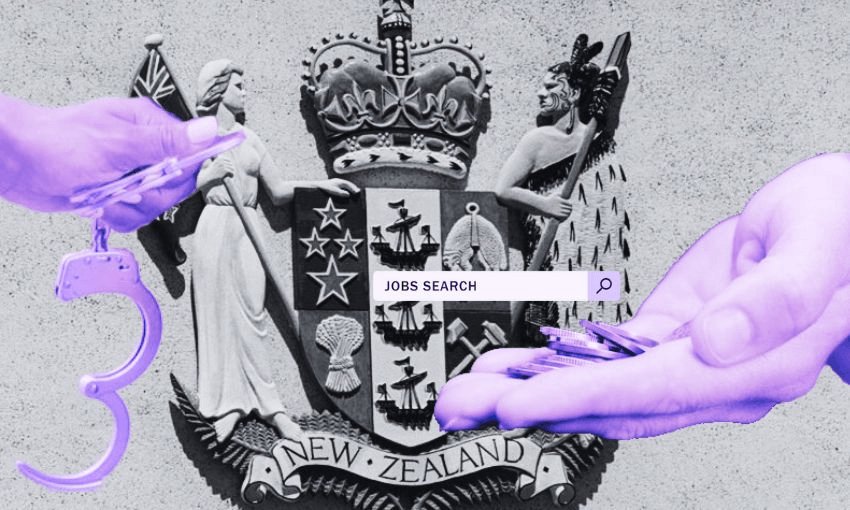New Zealanders are in agreement about what causes crime. But how to tackle it is a different question.
A recent global survey has found 62% of New Zealanders believe poverty and unemployment are the most significant causes of crime and violence. This perception is nine points higher than the global average (53%), and of the 31 countries featured in the Ipsos poll, sees Aotearoa rank in the top six for rating this factor as a leading cause. Researchers recognise a direct link between the two, but it doesn’t mean every person in poverty is committing crimes, nor every criminal living in poverty.
A recent reporting trend has been the rise in youth crime, which police minister Mark Mitchell has blamed on a lack of “serious repercussions” for younger criminals, saying “offenders feel emboldened to go out and commit crime.” It’s a different narrative to the one being told by some youth offenders who have spoken to journalists, who say they turned to crime after witnessing abuse and deprivation at home.
The online Ipsos survey questioned 1,000 adult New Zealanders under the age of 75 between March and April 2024, and the perception remained strong across generational lines, with 66% of Baby Boomers agreeing with poverty and unemployment being the driving force for crime, 63% for Millennials, and 60% for Gen X and Z.
So how bad is crime?
Crime data can be recorded and interpreted in many different ways, so there’s no black-and-white answer. But the Ministry of Justice’s latest NZ Crime and Victims Survey, released in June 2024, found the overall rate of victimisation (meaning crimes reported to police) has remained steady since 2018 in New Zealand. This contrasts with repeated claims from the prime minister and government ministers that crime is out of control. Fraud, followed by burglaries then physical offences (such as assault or robbery), were the most common crimes in the nation.
However, youth crime has increased, according to a Ministry of Justice report, and it is one of the most visible crimes in the media due to concern around the age of the offenders and the fact that a large majority of youth crimes are thefts. Research from the ministry shows youth crime rose from 8,220 charges against young people aged 10-17 in 2022 to 11,127 charges in 2023. It’s the highest number of youth crime charges in the last decade, as rates had remained between the 7,000 and 9,000 mark over the years.
And how bad is unemployment and poverty?
Unemployment in Aotearoa is currently at 4.3%, up from 3.4% this time last year, and is predicted to rise above 5% by the end of the year. Economists have previously predicted employment would need to rise above 4.5% in order to bring inflation down.
A large number of job losses in 2024 have been in the public sector, where the average salary is about $35,000 higher than the median salary in Aotearoa, though most of these cuts are not covered in Stats NZ’s unemployment data update. The professional services, agriculture, forestry, fishing, administration and support service and manufacturing sectors have also seen significant job losses this year. Multiple studies have shown a connection between a rise in unemployment and a rise in crime, with high numbers of burglaries, theft and fraud linked to areas with high unemployment rates.
The Ipsos survey showed 46% of New Zealanders believe creating jobs and boosting the economy should be the government’s main priority, compared with 31% who say protecting local citizens’ health and environment, and 23% who believe the focus should be on stopping or reducing crime.
How is the government tackling crime?
The government’s “tough on crime” stance has seen the introduction of youth boot camps, or “military academies”, for recidivist offenders aged 15-17. Despite expert advice, including from the New Zealand Defence Force, arguing boot camps are ineffective for young offenders and may unfairly target those with disabilities and mental health issues, minister for children Karen Chhour has repeatedly defended the government’s decision to bring them back. The last youth boot camp run in Aotearoa, introduced by the then Key-led National government, returned an 80% reoffending rate.
In another bid to lessen youth crime, the government has introduced the Attendance Action Bill, aimed at increasing attendance rates for school students in a nation with an attendance rate of 46%, according to associate education minister David Seymour, who oversaw the drafting of the bill and will bring proposals related to the bill to cabinet at a “later date.” Though Seymour hasn’t explicitly drawn a link between truancy and youth crime, a connection between the two issues has been recognised by experts.
A revised edition of the Three Strikes Bill has also been introduced to parliament, expected to pass with the support of the coalition government, to target recidivists committing serious violent and sexual offences. The law, which was repealed by the Labour government in 2022, had been criticised for being responsible for the over-incarceration of Māori and Pasifika.
The government has also proposed new anti-gang legislation in a bid to curb crime, including a ban on gang patches in public, prevention of gang members gathering in public or communicating with each other and harsher sentences for being involved in a gang. Guidance from the Ministry of Justice to the government advised there is “no evidence to suggest that a suppression approach will work to reduce long-term offending behaviours by gangs, or eliminate gangs altogether”, however, justice minister Paul Goldsmith has maintained the belief this ban will reduce criminal activity within gangs.
Alongside punishment measures is a promise to deliver more frontline police, though the government’s recent win in a pay dispute with the Police Association union may see a number of officers leave the force, after 200 left in 2023.
For those already on bail or in custody, the government promised in its 100-day plan to deliver more rehabilitation support to prisoners. A revision of the Corrections Act 2004 will “make it explicit … that prisoners who are on remand and convicted of a crime will be provided with rehabilitation that helps address the causes of their offending,” Mitchell said in a statement. Other amendments to the bill include an expectation for remand prisoners without a conviction to be provided with reintegration services and other “non-offence focused support,” while in prison, which covers alcohol and drug treatment as well as educational or behavioural skills programmes.
What is the government doing about poverty and unemployment?
The government has made some strides in addressing the financial strain felt by New Zealanders, though a focus on the “squeezed middle” means the poorest may be worse off. One solution to support those struggling has been the increase in in-work tax credit for working families announced in Budget 2024, which will see the wealthiest 20% of families benefiting most from the cuts, with $39 extra in the pocket each week, while the poorest 20% of households receive an extra $13 weekly.
A statement from the government in Budget 2024 outlined “living in a benefit-dependent home” as being a key driver of child poverty. To combat this, a target of 50,000 fewer beneficiaries on the Jobseeker’s Benefit has been set for the next six years. This goal will curb the rise of welfare dependency, according to Louise Upston, minister for social development, and address workforce shortages. Recently, the Ministry of Social Development (MSD) set up its first full-time phone service with the goal of providing more beneficiaries with case managers, who can support the recipients in finding work. However, those who do not pick up the phone for their case manager without a meaningful excuse will face sanctions where their payments will be decreased or halted, and given large numbers of sudden job losses in New Zealand, the Jobseeker’s Benefit has seen thousands more applicants, with June 30 figures released by the MSD up 14,709 people from June 30 2023.
There is a link between areas of New Zealand with the highest levels of deprivation – Northland, Gisborne, Waikato, South Auckland, and areas of Christchurch and the Bay of Plenty – and areas with high rates of crime. What exists in both communities – those with high levels of poverty and/or high levels of crime – is a lack of opportunity and added desperation.
In the tough-on-crime crackdown, the government also highlighted a need to raise awareness for victims of crime, who are more likely to be Māori and/or LGBT. The government has pledged to have 20,000 fewer victims of assault (including sexual) and robbery by 2030, and 15% less youth offenders in the same time frame. Introducing a three strikes law has historically not reduced crime in Aotearoa, which already has a higher incarceration rate than the UK and Australia.
So, what now?
It is clear from the accounts of youth offenders that the drive to commit crime often begins in a home without financial, emotional and mental support. New Zealanders clearly recognise a link between poverty and unemployment and crime, but whether this is a sympathetic view (a solo mother steals to provide for hungry children) or a more critical perspective (youths commit crime because they don’t care about the law) will differ from person to person.
In 2009, following the Drivers of Crime forum, the National government identified four key areas which needed action to address the drivers of crime: at-risk maternity and early parenting support; programmes to address behavioural issues in young children; prevention of alcohol-related harm and availability of drug and alcohol treatment services; and management of low-level repeat offenders.
All of these drivers are made worse when combined with poverty, and often they are already linked – families with a significant lack of resources may struggle to provide meaningful care for themselves and children with behavioural issues, alcohol misuse is greater in low socio-economic areas, and repeat offenders are most likely to be Māori, who are also more likely than most to live in poverty.
The connections are clear, and the majority of New Zealanders can identify them. Where governments may differ is in choosing whether to focus more on the causes or the punishments.

